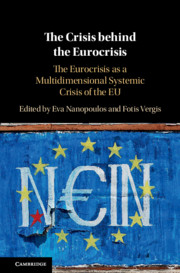Book contents
- The Crisis behind the Eurocrisis
- The Crisis behind the Eurocrisis
- Copyright page
- Dedication
- Contents
- Contributors
- Preface
- Acknowledgements
- Introduction The Elephant in the Room
- 1 There Is No (Legal) Alternative
- Part I The Crisis as a Crisis of the EU’s Identity
- Part II The Crisis as a Crisis of the EU’s Political and Democratic Legitimacy
- Part III The Crisis as a Crisis of the EU’s Economic Model
- Part IV The Crisis as a Crisis of the EU’s Social Character
- Part V Joining the Dots and the Way Forward
- Index
Part I - The Crisis as a Crisis of the EU’s Identity
Published online by Cambridge University Press: 07 July 2019
- The Crisis behind the Eurocrisis
- The Crisis behind the Eurocrisis
- Copyright page
- Dedication
- Contents
- Contributors
- Preface
- Acknowledgements
- Introduction The Elephant in the Room
- 1 There Is No (Legal) Alternative
- Part I The Crisis as a Crisis of the EU’s Identity
- Part II The Crisis as a Crisis of the EU’s Political and Democratic Legitimacy
- Part III The Crisis as a Crisis of the EU’s Economic Model
- Part IV The Crisis as a Crisis of the EU’s Social Character
- Part V Joining the Dots and the Way Forward
- Index
Summary
This chapter focuses on the trajectory of the European Union in order to elucidate and discuss its current problems. My main argument unfolds on the historically proven premise that the uneven and combined development of different national economies produces a major contradiction between the trend for greater integration and the continued assertion of national interests, a contradiction which is not likely to be transcended in the near future. My analysis brings forward two points, through a historical exploration of the European integration process.
First, I suggest that what invites further research and guides the formation and the development of the European integration process is geopolitical antagonism. This antagonism has two dimensions. The first revolves around the EU Member States, as countries in competition with each other, and the second encapsulates the ‘external’ antagonism of these nations as parts of a single entity (Europe) vis-à-vis the big geopolitical powers outside Europe (the Soviet Union in a former period, the United States, Russia and China nowadays).
- Type
- Chapter
- Information
- The Crisis behind the EurocrisisThe Eurocrisis as a Multidimensional Systemic Crisis of the EU, pp. 49 - 98Publisher: Cambridge University PressPrint publication year: 2019

